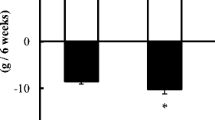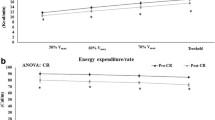Abstract
In many cases, athletes compensate for nutrient deficiencies due to a reduced dietary intake by taking supplements or other means. However, in what ways nutrients are utilized by the body when it is deficient in energy and yet receives adequate amounts of the required nutrients are unclear. We therefore examined the effect of the balance between available energy and iron intake on the iron nutritional status of athletes. The experiment was conducted in two parts. Four-week-old male rats were divided into two groups based on energy and iron sufficiency: Experiment 1 was energy-sufficient and iron-sufficient (ES-FeS) and energy-sufficient and iron-deficient (ES-FeD). Experiment 2 was energy-deficient and iron-sufficient (ED-FeS) and energy-deficient and iron-deficient (ED-FeD) groups. All rats were made to perform climbing exercises 3 days a week at 5 P.M. The results showed that a significantly higher hematocrit, hemoglobin, plasma iron concentration, and TfS were found in the iron-sufficient group than in the iron-deficient group, TIBC was significantly lower in the iron-sufficient group than in the iron-deficient group, and TfS was significantly higher in the iron-sufficient group than in the iron-deficient group, irrespective of energy intake. It was suggested that restricting both iron and energy intake may significantly decrease the amount of iron in the liver and accelerate the metabolic turnover of red blood cells, while restricting iron intake but providing adequate energy intake suggested that resistance exercise–induced tissue iron repartitioning was not altered by iron sufficiency or deficiency.
Similar content being viewed by others
Data Availability
This study provides an impetus to reconsider the idea of limiting energy intake and supplementing with deficient nutrients.
Change history
01 March 2023
A Correction to this paper has been published: https://doi.org/10.1007/s12011-023-03617-z
References
Ehn L, Carlmark B, Hoglund S (1980) Iron status in athletes involved in intense physical activity. Med Sci Sports Exerc 12:61–64
Dufaux B, Hoederath A, Streitberger I, Hollmann W, Assmann G (1981) Serum ferritin, transferrin, haptoglobin, and iron in middle- and long-distance runners, elite rowers, and professional racing cyclists. Int J Sports Med 2(1):43–46
Dressendorfer RH, Wade CE, Amsterdman EA (1981) Development of a pseudoanemia in marathon runners during a 20-day road race. JAMA 246:1215–1218
Wijn JF, De Jongeste JL, Monsterd W, Willebrand D (1971) Hemoglobin, packed cell volume, and iron binding capacity of selected athletes during training. Nutr Metab 13:129–139
Radomski MW, Sabiston BH, Isoard P (1980) Development of sports anemia in physically fit men after daily sustained submaximal exercise. Aviat Space Environ Med 51:41–45
Joy E, Kussman A, Nattive A (2016) 2016 update on eating disorders in athletes: a comprehensive narrative review with a focus on clinical assessment and management. Br J Sports Med 50:154–162
Ishibashi A, Maeda N, Kojima C, Goto K (2022) Iron metabolism following twice a day endurance exercise in female long-distance runners. Nutrients 14:1907
Weaver CM, Rajaram S (1992) Exercise and iron status. J Nutr 122:782–787
Cook JD (1994) The effect of endurance training on iron metabolism. Semin Hematol 31:146–154
Sim M, Garvican-Lewis LA, Cox GR, Govus A, Mckay AKA, Stellingwerff T, Peeking P (2019) Iron considerations for the athlete: a narrative review. Eur J Apple Physiol 119:1463–1478
Hinton PS (2014) Iron and the endurance athlete. Appl Physiol Metab 39:1012–1018
Coates A, Mountjoy M, Burr J (2017) Incidence of iron deficiency and iron deficient anemia in elite runners and triathletes. Clin J Sport Med 27(5):493–498
Nattiv A, Loucks AB, Manore MM, Sanbom CF, Sundgot-Borgen J, Warrenet MP (2007) American college of sports medicine position stand. The female athlete triad. Med Sci Sports Exerc 1867–1882
Mountjoy M et al (2014) The IOC consensus statement:beyond the female athlete triad-relative energy deficiency in sports(RED-S). Br J Sports Med 48:491–497
Heffernan SM, Horner K, De Vito G, Conway GE (2019) The role of mineral and trace element supplementation in exercise and athletic performance: a systematic review. Nutrients 11:696
Reeves PG, Nielsen FH, Fahey GC Jr (1993) AIN-93 purified diets for laboratory rodents: final report of the American Institute of Nutrition ad hoc writing committee on the reformulation of the AIN-76A rodent diet. J Nutr 123:1939–1951
Fujii T, Asai T, Matsuo T, Okamura K (2011) Effect of resistance exercise on iron status in moderately iron-deficient rats. Biol Treace Elem Res 144:983–991
Fujii T, Matsuo T, Okamura K (2012) The effects of resistance exercise and post-exercise meal timing on the iron status in iron-deficient rats. Biol Trace Elem Res 147:200–205
Fujii T, Matsuo T, Okamura K (2014) Effect of resistance exercise on iron absorption and balance in iron-deficient rats. Biol Trace Elem Res 161:101–106
International Nutritional Anemia Consultative Group (1985) Measurements of iron status, Washington DC. The Nutrition Foundation Inc 12–22
Tobin BW, Beard JL (1989) Interactions of iron deficiency and exercise training in male Sprague-Dawley rats: ferrokinetics and hematology. J Nutr 119:1340–1347
Masini A, Salvioli G, Cremonesi P, Botti B, Gallesi D, Ceccarelli D (1994) Dietary iron deficiency in the rat.I. Sbnormalities in energy metabolism of the hepatic tissue. Biochim Biophys Acta 1188:46–52
Dhur A, Galan P, Hercberg S (1990) Effect of decreased food consumption during iron deficiency upon growth iron status indicators in the rat. Ann Nutr Metab 34:280–287
Strause L, Hegenauer J, Saltman P (1983) Effects of exercise on iron metabolism in rats. Nutr Res 3:79–89
Ruckman KS, Sherman AR (1981) Effects of exercise on iron and copper metabolism in rats. J Nutr 111:1593–1601
Navas FJ, Cordova A (2000) Iron distribution in different tissues in rats following exercise. Biol Trace Elem Res 73:259–268
Beard JL (2001) Iron biology in immune function, muscle metabolism and neuronal functioning. J Nutr 131(2S-2):568S-579S
Walcyk T, von Blanckenburg F (2005) Deciphering the iron isotope message of the human body. Int J Mass Spectrom 242:117–134
Author information
Authors and Affiliations
Contributions
Fujii was responsible for breeding, dissection, analysis, data analysis, writing, and discussion. Kitaguchi was in charge of dissection and analysis. Okamura was in charge of discussion.
Corresponding author
Ethics declarations
Competing Interests
The authors declare no competing interests.
Additional information
Publisher's Note
Springer Nature remains neutral with regard to jurisdictional claims in published maps and institutional affiliations.
The original version of this article unfortunately contained a mistake.
In the last paragraph of the discussion, "On comparing the tissue iron content, the amount of iron in the whole spleen tended to be higher in ED-FeS than in ED-FeD (p=0.08)" should be changed to "On comparing the tissue iron content, the amount of iron in the whole spleen tended to be higher in ED-FeD than in ED-FeS (p=0.08)".
Rights and permissions
Springer Nature or its licensor (e.g. a society or other partner) holds exclusive rights to this article under a publishing agreement with the author(s) or other rightsholder(s); author self-archiving of the accepted manuscript version of this article is solely governed by the terms of such publishing agreement and applicable law.
About this article
Cite this article
Fujii, T., Kitaguchi, M. & Okamura, K. Effect of the Energy Intake on the Iron Status of Resistance Exercises Performed in Rats. Biol Trace Elem Res 201, 5272–5277 (2023). https://doi.org/10.1007/s12011-023-03594-3
Received:
Accepted:
Published:
Issue Date:
DOI: https://doi.org/10.1007/s12011-023-03594-3




